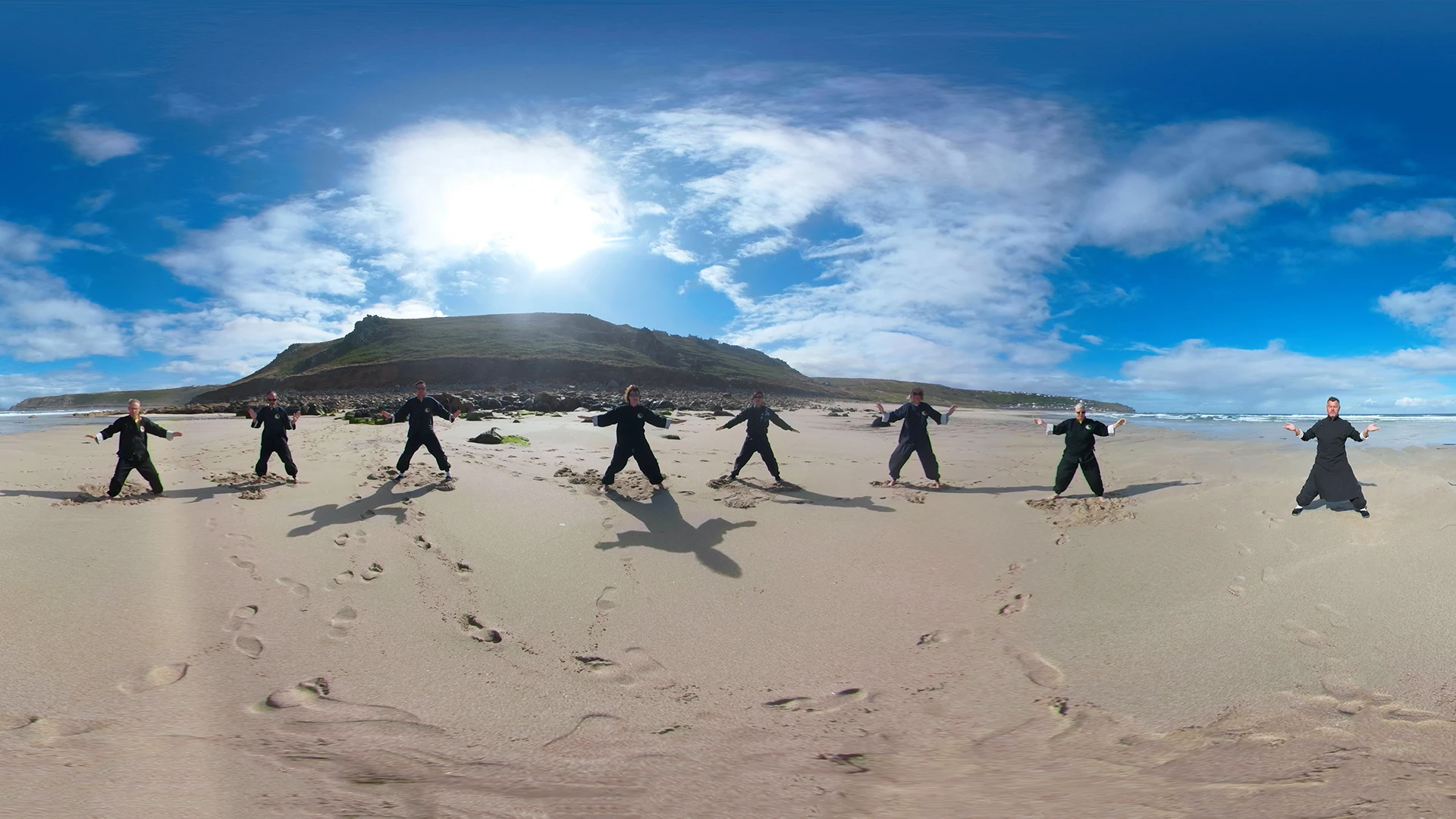
Sticky Hands, also known as Yīfù shǒu (依附手) is a fundamental exercise in Lee Style Tai Chi that is taught to beginners as a way to introduce them to the principles of Tai Chi and to prepare them for more advanced techniques. While some may see Sticky Hands as a simple exercise, it is actually a complex and multifaceted practice that offers a range of benefits for practitioners.
Developing sensitivity
One of the main aspects of Sticky Hands is the cultivation of sensitivity and connection with one’s partner. In the exercise, two practitioners stand facing each other and place their hands on each other’s forearms. They then begin to move their arms and bodies in unison, following each other’s movements and trying to maintain a constant connection. This requires a high level of sensitivity to the partner’s movements and intentions and helps to develop the ability to read and respond to subtle changes in body position and energy.
Cultivating Qi
Another aspect of Sticky Hands is the development of internal energy or qi. By maintaining a constant connection with their partner, practitioners learn to circulate their energy and to use it to guide and control their partner’s movements. This involves the use of spiraling movements, which help to increase the flow of energy through the body and to connect the upper and lower body.
Learning to sense timing
Sticky Hands also emphasizes the importance of timing and rhythm in Tai Chi. Practitioners must learn to move in sync with their partner, to maintain a constant flow of movement, and to execute techniques at the right moment. This requires a high level of concentration and focus, and helps to develop a sense of timing and rhythm that can be applied to other aspects of Tai Chi practice.
The psychological aspect
In addition to these physical aspects, Sticky Hands also has a number of mental and emotional benefits. The exercise requires practitioners to be present and focused, to let go of distracting thoughts and emotions, and to remain calm and centered even in the face of challenge or resistance from their partner. This level of mindfulness and emotional control can be applied to many different aspects of life, including work, relationships, and personal growth.
Overall, Sticky Hands is a foundational practice in Lee Style Tai Chi that offers a range of benefits for both beginners and more advanced practitioners. By developing sensitivity, connection, internal energy, timing, and emotional control, practitioners can gain a deeper understanding of themselves and their interactions with others, both in the context of Tai Chi and in daily life. As such, it is an essential part of a holistic Tai Chi practice that emphasizes both solo and partner work as equally important in line with the Taoist principle of yin-yang balance.
Principles of Sticky Hands
- Yielding: The first principle of sticky hands is yielding. Yielding means allowing your partner’s energy to flow into you without resisting or pushing back. When your partner pushes, you soften your joints and move with the push, rather than against it. Yielding is like bending like a tree in the wind instead of resisting and breaking.
- Listening: The second principle of sticky hands is listening. Listening means paying attention to your partner’s movements and responding accordingly. When your partner moves, you move with them, like a dance. Listening is like being a detective, trying to read your partner’s intentions and movements.
- Sticking: The third principle of sticky hands is sticking. Sticking means maintaining contact with your partner and keeping your connection. When your partner moves, you follow them with your hands and body, maintaining the connection. Sticking is like two magnets, attracting and repelling each other while staying connected.
- Neutralizing: The fourth principle of sticky hands is neutralizing. Neutralizing means redirecting your partner’s energy away from you. When your partner pushes, you redirect their energy away from you and towards the ground. Neutralizing is like using your partner’s energy against them, like a judo master.
- Rooting: The fifth principle of sticky hands is rooting. Rooting means being grounded and stable. When you are rooted, you are like a tree with deep roots, unmovable and strong. Rooting is like being an anchor, providing stability and balance to your partner.
How Sticky Hands Can Improve Your Tai Chi Practice
Nowadays more and more teachers are only teaching the forms and they neglect partner work. This flies in the face of everything our teachers taught us. Sticky Hands is an essential part of Tai Chi practice. It can help you develop sensitivity, awareness, and adaptability. By practicing sticky hands, you can improve your Tai Chi practice in the following ways:
- Develop Sensitivity: Sticky hands can help you develop sensitivity to your partner’s movements. By listening to your partner’s movements, you can learn to anticipate their intentions and respond accordingly. This sensitivity can be applied to your solo Tai Chi practice, helping you become more aware of your own movements and how they affect your body.
- Improve Balance: Sticky hands can help you improve your balance by teaching you to root and maintain your stability. By staying rooted and balanced, you can avoid being pushed off balance by your partner’s movements. This balance can be applied to your solo Tai Chi practice, helping you maintain your balance and stability while performing the movements.
- Increase Flexibility: Sticky hands can help you increase your flexibility by teaching you to yield to your partner’s movements. By softening your joints and moving with your partner, you can improve your flexibility and range of motion. This flexibility can be applied to your solo Tai Chi practice, helping you perform the movements with more fluidity and grace.
- Reduce Stress: Sticky hands can help you reduce stress by teaching you to relax and let go of tension. By yielding to your partner’s movements and focusing on your breath, you can release tension and reduce stress. This relaxation can be applied to your solo Tai Chi practice, helping you achieve a state of calm and relaxation.
- Enhance Martial Applications: Sticky hands is not just a partner exercise, it also has martial applications. By practicing sticky hands, you can develop skills that can be applied in self-defense situations. Sticky hands can teach you how to redirect your opponent’s energy, neutralize their attacks, and maintain your balance and stability. These skills can be applied to your solo Tai Chi practice, helping you develop a deeper understanding of the martial applications of Tai Chi.
While Tai Chi is a serious practice, it doesn’t have to be boring. In fact, Tai Chi can be quite humorous, especially when practicing sticky hands with a partner. Here are a few examples of the humor that can be found in sticky hands:
- The Wobbly Partner: We’ve all had a partner who is less stable than a Jenga tower. When practicing sticky hands with a wobbly partner, it can be challenging to maintain your balance and stability. However, it can also be quite comical, especially when both partners are trying to regain their balance at the same time.
- The Overly Aggressive Partner: On the other end of the spectrum, we have the overly aggressive partner who is determined to push you across the room. When practicing sticky hands with an aggressive partner, it can be tempting to resist and push back. However, this is the opposite of what sticky hands is all about. Instead, try yielding and redirecting their energy. If all else fails, a well-timed tickle attack can always diffuse the tension.
- The Distracted Partner: We’ve all had a partner who is easily distracted. Maybe they’re checking their phone, or maybe they’re daydreaming about their lunch. When practicing sticky hands with a distracted partner, it can be challenging to maintain their focus. However, it can also be an opportunity to practice your skills of sensitivity and adaptability. Try gently redirecting their attention back to the exercise, or use their distraction as an opportunity to practice your neutralizing skills.
Neutralizing
One of the essential principles of Tai Chi is the principle of neutralizing. Neutralizing is the process of redirecting an opponent’s force in a way that avoids a direct confrontation. The principle of neutralizing is essential in Tai Chi, as it allows us to use our opponent’s energy against them, rather than using our own energy in opposition to theirs.
Neutralizing involves the use of yielding and softness, rather than force and strength. To neutralize an opponent’s force, we must first yield and blend our movements with theirs. This means that we must not try to block or resist their force, as this would be a hard style technique that is not in line with Tai Chi’s soft style.
Yielding requires us to withdraw our body and give ourselves enough working space to then start to circle their arm or hand away from us, to avoid bodily contact. This approach allows us to create a space for ourselves that gives us more time to sense our partner’s intentions and movements.
The process of yielding allows us to avoid direct confrontation with our partner’s force, which is an essential aspect of the neutralizing principle. By yielding, we can sense our partner’s movements and intentions, which allows us to move with them seamlessly.
Once we have blended our hand movements with our partner’s, we can start to redirect their force if necessary. However, this redirection should not involve any forceful or aggressive movements. Instead, we should use our partner’s movements entirely and allow them to guide us.
This approach is in line with the Taoist principle of Wuwei, which emphasizes the idea of achieving our goals without force or resistance. In Tai Chi, this means allowing our partner to lead and guide us, rather than trying to redirect their movements or force them in a particular direction.
The paradox of this approach is that by relinquishing control entirely, we take absolute control. Rather than using trickery or subtle redirection, we allow our partner’s movements to guide us, which gives us the freedom to move in any direction we desire.
To use the principle of neutralizing effectively in Tai Chi, we must develop a deep sense of sensitivity and awareness. We must be attuned to our partner’s movements and intentions, allowing us to move with them seamlessly. This requires a significant amount of practice and dedication, as well as an understanding of Tai Chi’s principles and techniques.
In conclusion, the principle of neutralizing is a vital component of Tai Chi practice. It involves the use of yielding and softness to redirect an opponent’s force in a way that avoids a direct confrontation. Neutralizing requires us to relinquish control entirely and allow our partner’s movements to guide us, in line with the Taoist principle of Wuwei. To use the principle of neutralizing effectively, we must develop a deep sense of sensitivity and awareness, allowing us to move with our partner seamlessly and take absolute control by relinquishing control entirely.


Leave a Reply